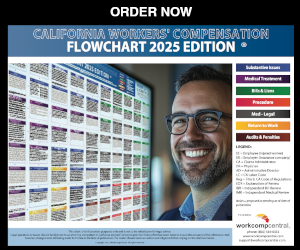Today is
Monday, March 31, 2025 -
Industry Insights
June 18, 2005
Voc Rehab, ADA, and FEHA - How it Fits Together
- State: California
- - 0 shares
A long story short: An employee was placed directly into a vocational rehabilitation plan without the employer having the opportunity to respond to an RU-94 or have the Americans with Disabilities Act (ADA) "conversation" with the employee. The employee is still in the plan, however the ADA "conversation" needs to be had. If as a result of the ADA "conversation," the employer needs to offer the employee a position, what about rehab? If the employee did accept an offer of a position, could plan just be terminated?
This is an excellent case study that shows employers, workers' compensation professionals and employment/labor practitioners exactly where the parallel universes of workers comp and FEHA/ADA collide.
Assuming that this Injured Worker is in fact a QID (Qualified Individual with a Disability) and protected under the California Fair Employment and Housing Act (FEHA), (we won't worry about the federal ADA here) the employer is obligated to engage this employee in an interactive discussion (as you say, ADA "conversation") regardless of what is happening in the realm of workers' comp. It would have been much better for the employer had they done that a long time ago, since if they can indeed accommodate the employee, vocational rehabilitation would not have been required.
Even though vocational rehabilitation is now in process, the employer should still proceed with that discussion with the employee and search for reasonable accommodations.
If they find a means to bring the employee back to work, then yes, vocational rehabilitation maintenance allowance (VRMA) stops.
What should then occur is preparation of a plan, RU-102, on the return to work (RTW) with same employer. The Qualified Rehabilitation Representative would either check box 1 -modified; or box 2-alternate; and describe the job, wages, accommodations etc. on the plan.
It is also recommended that the employer keep copious notes of the meeting and agreements with employee for themselves, since the Plan is a work comp issue and the reasonable accommodation is an employer/employee issue.
If the employer determines that they cannot provide a reasonable accommodation that allows the employee to return to work either to the same job, modified, or an alternative job within the company, of course the employee continues in his vocational rehabilitation program. VRMA should continue while this process takes place.
Furthermore, communication and documentation should occur between the employer and employee as this is an employment issue that may affect work comp, not the other way around. The employment determination letter, i.e., a letter advising the employee whether or not employer can provide a reasonable accommodation should emanate from the employer.
The workers' compensation policy does not cover matters of employment nor defend against losses stemming from employment suits. Employers are more exposed than ever to risk of civil litigation from FEHA-ADA suits, especially since the demise of vocational rehabilitation. Employers must be proactive by developing and implementing RTW programs which include the interactive process with their employees who have work restrictions whether occupational or non-occupational.
Once the 30 days/RU-94 period has passed and the case is in voc rehab, any job offered has to pass the "suitable gainful employment" sniff test, which is a higher threshold than the RU-94 requirements (lasting one year, 85% of salary, etc).
If you find an appropriate job during the interactive process, offer it. If the employee accepts, have the counselor write up the plan around that job, get it approved by the Rehab Unit and file for termination.
If the employee rejects the job, it would still be advisable to have the counselor to evaluate it. The preference in vocational rehabilitation has always been to return the employee to work with the same employer when possible, unless the employee or counselor has a compelling reason why the job is not "suitable".
Of course, then you get a disgruntled EE and everything that goes along with that.
-------------------------------
The views and opinions expressed by the author are not necessarily those of workcompcentral.com, its editors or management.
This is an excellent case study that shows employers, workers' compensation professionals and employment/labor practitioners exactly where the parallel universes of workers comp and FEHA/ADA collide.
Assuming that this Injured Worker is in fact a QID (Qualified Individual with a Disability) and protected under the California Fair Employment and Housing Act (FEHA), (we won't worry about the federal ADA here) the employer is obligated to engage this employee in an interactive discussion (as you say, ADA "conversation") regardless of what is happening in the realm of workers' comp. It would have been much better for the employer had they done that a long time ago, since if they can indeed accommodate the employee, vocational rehabilitation would not have been required.
Even though vocational rehabilitation is now in process, the employer should still proceed with that discussion with the employee and search for reasonable accommodations.
If they find a means to bring the employee back to work, then yes, vocational rehabilitation maintenance allowance (VRMA) stops.
What should then occur is preparation of a plan, RU-102, on the return to work (RTW) with same employer. The Qualified Rehabilitation Representative would either check box 1 -modified; or box 2-alternate; and describe the job, wages, accommodations etc. on the plan.
It is also recommended that the employer keep copious notes of the meeting and agreements with employee for themselves, since the Plan is a work comp issue and the reasonable accommodation is an employer/employee issue.
If the employer determines that they cannot provide a reasonable accommodation that allows the employee to return to work either to the same job, modified, or an alternative job within the company, of course the employee continues in his vocational rehabilitation program. VRMA should continue while this process takes place.
Furthermore, communication and documentation should occur between the employer and employee as this is an employment issue that may affect work comp, not the other way around. The employment determination letter, i.e., a letter advising the employee whether or not employer can provide a reasonable accommodation should emanate from the employer.
The workers' compensation policy does not cover matters of employment nor defend against losses stemming from employment suits. Employers are more exposed than ever to risk of civil litigation from FEHA-ADA suits, especially since the demise of vocational rehabilitation. Employers must be proactive by developing and implementing RTW programs which include the interactive process with their employees who have work restrictions whether occupational or non-occupational.
Once the 30 days/RU-94 period has passed and the case is in voc rehab, any job offered has to pass the "suitable gainful employment" sniff test, which is a higher threshold than the RU-94 requirements (lasting one year, 85% of salary, etc).
If you find an appropriate job during the interactive process, offer it. If the employee accepts, have the counselor write up the plan around that job, get it approved by the Rehab Unit and file for termination.
If the employee rejects the job, it would still be advisable to have the counselor to evaluate it. The preference in vocational rehabilitation has always been to return the employee to work with the same employer when possible, unless the employee or counselor has a compelling reason why the job is not "suitable".
Of course, then you get a disgruntled EE and everything that goes along with that.
-------------------------------
The views and opinions expressed by the author are not necessarily those of workcompcentral.com, its editors or management.
Advertisements
Columns
- Moore: Critical Workers' Comp Business Change Reporting Requirement 03/31/25
- Mussack: AMA Guides, State PDRS Can Differ on Rating Instructions 03/28/25
- Kamin: Hope Springs Eternal With New District Attorney 03/26/25
- Langham: DOGE 2025 03/24/25
- Paduda: What's Happening in Work Comp M&A? 03/21/25
- Gelman: Will DOGE Changes Cause Workers' Comp Costs to Rise? 03/20/25
- Gelman: High Court OKs Referral Fees 03/19/25
- Snyder: The Importance of Taking Notes 03/17/25
- Snyder: How Negotiation Is Like Art Forgery 03/14/25
- Gelman: Daylight Saving and Workplace Injuries 03/12/25
- Geaney: Work-Related Knee Injury Can Constitute a Disability Under ADA 03/10/25
- Montgomery: $300K to Study Nonexistent UR Data 03/07/25
- Paduda: The State of Florida Workers' Comp 03/05/25
- Montgomery: How California's Rigged Workers' Comp System Cheats Providers 03/03/25
- Kamin: Auto Accidents, DUIs and Apportionment 02/28/25
- Ginther: Third-Party Claims Don't Have to Be Confusing 02/26/25
- Burns: Is Personal Appearance at Trial Really Necessary? 02/24/25
- Martin: How to Compel the Depo Transcript to a PQME 02/21/25
- CAAA: Proposed Guideline Would Ban Cannabis for Injury Treatment 02/19/25
- Stith: States With the Most Opportunity to Improve Care for Injured Workers 02/14/25
Now Trending
- Workers' Compensation News
-
Calif. Amended
Bill Proposes SIBTF Changes, New
Name for…
Posted on Mar 26, 2025Scott Silberman says: “Legislative changes in 2004 and 2014 have reduced the pure premium rate…”
-
Calif. Bill
Proposes Med-Legal…
Posted on Mar 26, 2025
-
Calif. Committee
Passes First Responder, Stone
Manufacturing Safety…
Posted on Mar 27, 2025
-
Calif. Amended
Bill Proposes 4850 Time Based on
County…
Posted on Mar 31, 2025
-
Calif. Senate
Committee to Hear More Comp Bills
April…
Posted on Mar 27, 2025
-
Calif. Lawmaker
Proposes IBR for Contract…
Posted on Mar 26, 2025
-
Calif. Cal/OSHA
Cites Construction Company $157,500
for Fatal Trench…
Posted on Mar 24, 2025
-
Md. Worker Waits
Too Long to Request Modification of
TTD…
Posted on Mar 25, 2025
-
Utah High Court:
Underinsured Motorist Exclusion
Hinges on Availability of Comp…
Posted on Mar 24, 2025
-
Ariz. High Court:
New Presumption Law Doesn't Apply
to Pending…
Posted on Mar 28, 2025
Jobs
Upcoming Events
Mar 20 – Apr 21, 2025
DWC Opens Registration for 32n
The California Division of Workers’ Compensation (DWC) is pleased to announce that registration fo …
May 12-14, 2025
NCCI Annual Insights Symposium
NCCI's Annual Insights Symposium (AIS) 2025 will deliver data-driven insights, providing workers c …
Jun 11-13, 2025
CCWC 2025 Educational Conferen
For two decades, CCWC has assembled the key players in the workers’ compensation arena for what is …
Social Media Links
WorkCompCentral
c/o Business Insurance Holdings, Inc.
c/o Business Insurance Holdings, Inc.
PO Box 1010
Greenwich, CT 06836
(805) 484-0333
Greenwich, CT 06836



No Comments
Log in to post a comment